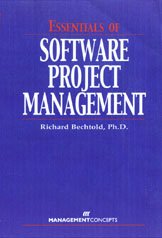
SUMMARY TABLE OF CONTENTS
(Go to the detailed table of contents)
|
|
 SUMMARY TABLE OF CONTENTS (Go to the detailed table of contents) |
Chapter 1 Project Management
in the Software Development Environment
Why Do Project Management?
Different Approaches to Project Management
The Challenging Environment of Software Development
What is Project Management?
The Role of the Project Manager in Today’s Software-
Intensive Environments
Where to Start?
PART II: ESSENTIALS OF PROJECT PLANNING
Chapter 2 Selecting the Best Processes
Identifying Your Project’s Key Strength
Selecting the Best Lifecycle
Selecting the Best Engineering Method
Chapter 3 Developing Plans
Developing Preliminary Plans
Developing Intermediate Plans
Developing Detailed Plans
Developing a Risk Management Plan
Organizing the Project Plan
Maintaining the Project Plan
Developing a Staffing Plan
PART III: ESSENTIALS OF PROJECT CONTROL
Chapter 4 Product Management
Managing Software In a Systems Context
Managing Requirements
Managing Product Complexity
Managing Configurations
Managing Defects
Ensuring Quality
Tracking Progress Using Earned Value Management
Using Product Measurements and Metrics
Maintaining Product Focus
Chapter 5 Process Management
Managing Software Processes in a Systems Context
Managing Your Project Staff
Managing Negotiations with Affected Groups
Managing Process Support Technology
Managing Process Complexity
Managing Interactions with Customers
Managing Interactions with Executive Management
Using Process Measurements and Metrics
Managing the Acquisition of Software Subcomponents
Controlling Your Project Control Activities
PART IV: ESSENTIALS OF PROJECT RECOVERY
Chapter 6 Diagnosing Project Control Effectiveness
Detecting Control Problems
Performing Routine Project Tracking
Leveraging Safety-Net Functions
Chapter 7 External Software Capability Audits
The Purpose of External Audits
External Audit Approach
Standard Rules for External Auditors
Preparing for and Participating in an External Audit
Chapter 8 Recovering
Projects from Insufficient Control
Identifying the Symptoms of Insufficient Control
Determining Types of Additional Control
Defining Additional Controls
Testing Additional Controls
Deploying Additional Controls
Monitoring Additional Controls
Chapter 9 Recovering Projects from Excessive Control
Identifying the Symptoms of Excessive Control
Determining Types of Control Reduction
Incrementally Relaxing Excessive Controls
Detecting Excessive Relaxation of Control
Chapter 10 Recovering Projects from Inappropriate Control
Identifying the Symptoms of Inappropriate Control
Planning the Control Shift
Implementing and Tracking the Control Shift
Addressing Human Factors
Chapter 11 Sustaining the Recovery
Amortizing the Recovery Effort
Overcoming Backlash
Overcoming Passive Resistance
Preventing Exhaustion
Gently Tempering Zealots
Avoiding Artificial Victory
Avoiding Polarizing Management Peers
Sharing Success
Identifying and Focusing on Project Management
Essentials
APPENDICES
Appendix A: Managing Defects Using Diagnostic Software
Architectures
Appendix B: Sample Approach for a One-Semester Course
in Software Project Management
Appendix C: Sample Approach for a One-Semester Course
in Software Project Management
Appendix D: References and Additional Reading